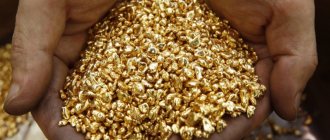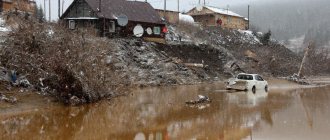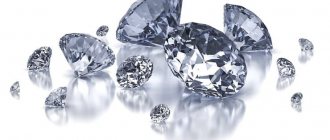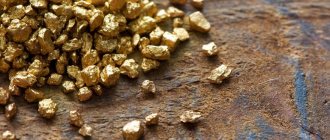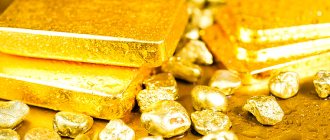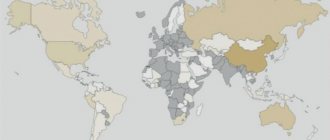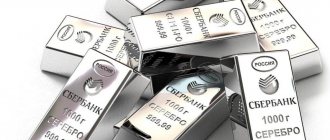Gold mining in Russia by individuals, in other words, by ordinary people-miners, was either encouraged by the state or prohibited. History has shown that by giving gold miners the opportunity to ordinary people to mine gold, the state only benefited from this. Indeed, during the reign of Peter I, most of the large deposits in Russia were discovered by ordinary people.
In many countries, particularly in Africa and Asia, illegal gold miners wash sand and climb into mines, risking their lives. How the state now regulates the activities of individuals in this area in Russia, what needs to be done now in order for individuals to be able to extract this precious metal legally, we will consider in more detail in this article.
Is gold mining by private individuals allowed in Russia - historical background on the legalization of mining
Until 2021, Russians were prohibited from mining gold on their own. Already in 2021, a bill has been developed allowing private owners to engage in mining.
Turning to history, it should be noted that gold mining is considered a medieval craft for the population of Russia, Kazakhstan, Australia, the USA and many other countries. Previously, there were no search restrictions. In the 19th century, the country had only a few known deposits in Siberia and the Urals. Gold miners came to Russia from remote regions to try their luck.
Plus 300 kg of gold
And yet, in general, there is little information in the public domain about the investment project to build a factory. Seligdar spoke about construction plans in 2021.
“Construction is due to the fact that there are reserves of primary refractory ore in the depths, gold from which can only be extracted at the factory. The Mining and Geological Design Institute (Moscow) was involved in the development of design documentation. Construction will take place in two stages and will last for two years,” the holding’s press service reported (we quote from the page - Ed.).
The holding's report for 2021 states: a plant for processing quartz-carbonate ores will appear at the Murzinsky deposit. It will allow us to additionally receive up to 300 kg of gold per year and extend the operation of the facility. For comparison: in 2021, according to the government of the Altai Territory, AS Poisk produced 644.9 kilograms of gold.
Construction of a gold recovery plant at the Murzinsky deposit.
Altairegion22.ru
The total cost of the factory project is 560 million rubles, commissioning of the facility is expected in the third quarter of 2021, as was also reported in the 2020 report. It is unclear whether construction will be completed in the third quarter. The holding’s social network announced the hiring of personnel for AS Search.
Specialists are required, in particular, for the gold recovery plant.
The main gold deposits in Russia
Throughout the Russian Federation there are about 1000 sites where gold is found. 15 regions are allocated for industrial production. 10 regions do not allow us to predict the volumes of metal mined. The country's largest gold deposits are:
- Fedorova Tundra;
- Lyubash-1;
- Urupskoe;
- Khudesskoe;
- R. Tavrota;
- R. Balbanyu;
- Berezovskoe;
- Maminskoe;
- R. Miass;
- Tominskoe;
- Kochkarovskoe;
- Svetlinskoe;
- Murtykty;
- Zapadno-Ozernoe;
- Novo-Uchalinskoe;
- Uzelginskoe;
- Chebachye;
- Mikheevskoe;
- Yubileiny;
- Podolsk;
- Komsomolskoe;
- Gayskoe;
- Vasin;
- Oktyabrskoe;
- Talnakhskoe;
- Norilsk-1;
- Maslovskoe;
- Golden;
- High;
- Blagodatnoe;
- Olimpiadinskoe;
- Titimukhta;
- White Mountain;
- Multivertex;
- Perevalnoe;
- Light;
- Ak-Sugskoe;
- Devil's Trough;
- Adjacent plot;
- Verninskoe;
- Sukhoi Log;
- Ugahan;
- R. Chayangro;
- Kholodninskoe;
- Delbe;
- Central;
- Rowan;
- Kurung;
- R. Kuranakh;
- R. Seligdar;
- R. Bol. Kuranakh;
- R. Bol. Tyrkanda;
- Gross;
- Bamskoe;
- Berezitovoe;
- Klyucheskoe;
- Ithakinskoe;
- Alexandrovskoe;
- Talatuiskoe;
- Darasunskoe;
- Baleyskoe;
- Taseevskoe;
- Novo-Shirokinskoe;
- Bystrinskoe;
- Kultuminskoe;
- Silver;
- Ikanskoe;
- Malomyrskoe;
- Albynskoe;
- Malmyzhskoe;
- Albazinskoe;
- Khakanja;
- Nezhdaninskoe;
- Kyuchus;
- Placer Camus;
- Placer Chugas;
- Drazhnoe;
- R. Berelech;
- Dry Ruslo Stream;
- Sturmovskoe;
- Pavlik;
- Degdekanskoe;
- Natalka;
- Dukatskoe;
- Rolling;
- Irbychan;
- Birkachan;
- Maple;
- Gerbil;
- Kekura;
- Dome;
- Double;
- R. Chaanay;
- Mayskoe;
- R. Nutekingenkyveem;
- Amethyst;
- Kumroch;
- Aginskoe;
- Rodnikovoe;
- Veduginskoe;
- Panimba;
- Bogolyubovskoe;
- Poputninskoe;
- Kingashskoe;
- Novo-Urskoe;
- Baranevskoe.
Mining gold in the river
What minerals are there in the Urals?
Truly, the list of treasures with which the Ural Mountains are rich is amazing. In addition to the richest deposits of gold, silver, copper, platinum, aluminum, and ferrous metals are mined in the Urals.
The region is rich in precious stones: diamonds, emeralds, amethysts, topazes. Deposits of semi-precious (ornamental) stones are found everywhere – malachite, jasper, marble, alexandrite, and chrysolite.
There are deposits of oil, gas and coal. In the Urals there is the world's largest deposit of refractory materials - talc, asbestos, dolomite, magnesite.
Why and where individuals were allowed to mine gold
Previously, citizens were not allowed to excavate gold on their own. Now this is allowed, but with a number of restrictions. For such activities, individuals are required to obtain a license that will allow metal laundering in areas of no more than 150 thousand square meters. within 5 years.
Russia has enormous potential for the development of gold mining tourism. In many regions there are mineralogical areas that are not of interest to legal entities in terms of industrial scale gold mining. But they could become bait for prospectors.
Organizing tours to places attractive to tourists means the creation of new jobs and financial profit for the regional budget. While vacationers who bought a tour would have the opportunity to search and launder gold and other stones, paying for equipment and licenses.
Recycling of radio components and gold recovery
During the Soviet era, mined metals, including precious ones, were massively used in all industries, and electronics was no exception. In Soviet-made radio and electronic devices, you can often find parts made of pure silver, platinum or gold, since they are very good electrical conductors.
How to extract precious metal from equipment?
Attention, information is for informational purposes only! This process is very dangerous, so you need to approach gold mining from radio components and similar equipment with the utmost caution and compliance with safety rules.
- First you need to remove all the parts that look like gold plated in color.
- Then prepare “regia vodka” (a mixture of nitric and hydrochloric acids) according to a special formula - this is a universal solvent that dissolves almost all organic compounds.
- The parts are placed in the solution for about 6 hours and completely dissolved. Since gold is a heavy metal, its molecules settle to the very bottom of the vessel.
- Next, you will need Hydrazine powder, which must be diluted with water and carefully poured into the aqua regia. Immediately at the bottom of the vessel, red flakes appear - this is gold.
- It needs to be collected and placed again in a new solution of hydrochloric and nitric acid.
- After passing 3 such circles, the lucky ones end up with several grams of pure gold in the form of separate threads.
- Fragments of gold are collected, melted, poured into some form and cooled.
- The output is a small gold nugget.
Basic requirements for legal private gold mining
- IP registration. People who want to independently engage in gold mining must obtain the status of an individual entrepreneur;
- obtaining a license. The document gives the right to choose an area of no more than 150 thousand square meters;
- surface method of gold mining. Miners are prohibited from using heavy equipment and only surface search tools are permitted;
- ban on blasting. Explosives are only permitted for use in the Far East as a pilot project;
- prohibition on hiring hired labor. An individual entrepreneur must carry out excavations independently, without hired employees;
- outside the zone of industrial gold mining. Work is carried out only in areas that are not subject to industrial processing. There are such areas in the Magadan region;
- restrictions on the amount of metal mined. An entrepreneur can extract no more than 10 kg of gold from one plot;
- immersion in the ground no more than 5 meters. This allows you to find only native gold located on the surface of the soil or placer gold.
More than 20 years perspective
Alexander Bobryshev, during his report to the governor, also said that in 2021, the gold mining volumes of the Pois Prospectors' Artel have slowed down somewhat due to claims from the supervisory agency.
“We slightly exceeded the production limits there, but the issue has been resolved,” he said, also explaining that by the end of 2021 the enterprise intends to reach the level of the previous 2020.
Krasnoshchekovsky district.
VK: Krasnoshchekovsky district.
In addition, according to the head, in July 2021, AS Poisk won an auction for the right to geological study, exploration and mining of ore gold in the Kurinsky area. The license was purchased for 32.2 million rubles and granted for 25 years. The predicted resources of ore gold in this area are estimated at 10.1 tons, Kommersant reported.
This is stable operation of the enterprise for more than 20 years,” said the head of the district.
Previously, altapress.ru reported that another company mining ore gold, Zoloto Kurya, emerged from bankruptcy proceedings, and arbitration approved a settlement agreement between the company and its creditors.
Murzinskoye field.
seligdar.ru
Punishment for mining gold worth more than a million rubles
If gold mining in Russia by private individuals is carried out in the amount of 1 million 500 thousand rubles, the violator will face imprisonment and penalties. According to the law, the circulation, transportation, purchase and sale of precious metals in especially large quantities provides for punishment:
- forced labor;
- imprisonment for 5 years and a fine of up to 500 thousand rubles;
- salary deduction for 3 years.
If an offense is committed by a group of persons, a fine of 1 million rubles is applied. or imprisonment for up to 7 years. Similar sanctions are also provided for accidental intrusion into someone else's gold mining site.
Illegal mining of precious metals
Thomas Walsh
Before becoming the owner of the legendary Camp Bird Mine, which produced more than $20 million worth of precious metals over 20 years, Thomas Walsh managed to move to America from his native Ireland, work in Massachusetts and catch the dreams of miners in Colorado. The turning point in Walsh's life was meeting Smokey Jones in South Carolina. The prospector offered Walsh a share in the Deadwood mine, but he refused, and later regretted it: over time, the site grew into the Homestake mine, one of the richest in North America.
The failure only spurred Walsh on: he firmly decided that next time he would not miss his chance. Hoping to find his own vein, the gold miner went to Colorado and was not mistaken. In the Ouray area, he discovered a deposit that later turned into the Camp-Berd Mine. And 20 years after the opening of the mine, Walsh sold it to a London syndicate and moved with his family to Washington, where they all quickly joined the social life of the city and became quite famous people.
Advertisement for a tour to California, 1850s. (wikimedia.org)
Thomas Walsh is remembered in America not only as a successful entrepreneur, but also as a philanthropist and defender of the rights of the working class. At his mine, people were provided with high wages and a place to live with excellent conditions and excellent food. In addition, Walsh was one of the first to advocate reducing the 10- and 12-hour workday to 8 hours. As a result, Walsh was able to gain surprising loyalty from workers and avoid the strikes that plagued Western mines in the late 1800s and early 1900s.
Procedure for obtaining official permission
How to obtain a gold mining license through official means:
- Registration of the status of individual entrepreneur and official taxpayer. For this you need:
- application in the prescribed form for registration;
- photocopy of passport.
- Site selection through Rosnedra agencies. The individual entrepreneur sends an application for a free territory and expects a response within a month;
- payment of the state fee to obtain a license - 7500 rubles;
- obtaining a license for private entrepreneurs through intermediaries. There are legal entities that help you obtain a license. This option speeds up the process of collecting and filling out documentation. Such a service for individual entrepreneurs will cost 100-200 thousand rubles.
Forms of activity of gold miners
The field of activity of active and energetic people has always been vast and varied. Gold mining, although dangerous at times, does not necessarily require a high-tech base and large financial resources. Gold mining can be carried out by individuals, large firms, and government agencies. At the same time, the Russian state either took an active role in gold mining or outsourced gold mining in Russia to individuals. At the present stage, corporations such as Kinross Gold, OJSC Yuzhuralzoloto, OJSC Severstal, etc. are mainly involved in gold. Until recently, gold mining in Russia by individuals was practiced in much smaller volumes.
When a license is not required
A gold license may not be required in the following cases:
- purchase or lease of an enterprise with all permits. In this case, it will be necessary to obtain a re-evaluation of the geological information about the deposit from government inspectors;
- work by agreement on the dumps of a gold mining enterprise. Private individuals can legally mine precious metals by concluding an agreement with gold mining companies. Often companies sell for a certain percentage the opportunity to develop their subsoil or areas where deposits do not allow for industrial production. But it is quite difficult for beginners to cooperate with such companies. More often than not, all the “good” sites are taken apart by former employees and partners of companies.
Bypassing the license
But what to do if the golden sparkle in your eyes is already preventing you from sleeping at night, but for one reason or another it is not possible for you to obtain a license? There is another way. You need to find a company that mines gold. Agree with its representatives to assign you a “workplace” somewhere on the dumps of their company. It is possible in those places where there is enough gold for one person, but the development of this place on an industrial scale is no longer profitable.
Naturally, the company should have obvious benefits from cooperation with you. And what could be more obvious than the percentage of profit from any substance you extract? In general, this scheme is realistic and justifies itself. However, it is quite rare. This is because such “breadcrumbs” from the “tables” of large companies are collected, most often, by former employees or good friends of members of the same companies. That is, all the hot spots have already been sorted out. But luck is such a thing.
Prospects for the development of private gold mining in Russia
According to the country’s leadership, the legalization of mining should bring the “black” market out of the shadows. The country's budget will be able to officially replenish gold reserves and the financial part, thanks to duty payments. At the same time:
- many new jobs will appear;
- citizens' earnings will increase;
- the population will begin to become more actively involved in one of the most profitable industries in the world.
Antique gold coins and bars
James Hurst
Gold mines made James Hearst the personification of the American dream: born into a rather poor family, by the end of his life he was able to amass a huge fortune and died one of the richest and most famous people of his time. Contemporaries said that Hirst had a “nose” for wealth-generating veins. The fact that he began mining gold as a boy also helped the future prospector achieve success. Hearst, forced to drop out of school, and his friends helped local miners, and when the gold rush hit California, he was ready for hard work.
Hearst went to the mines in the company of two cousins. At first, luck turned away from the young people: at the end of a year of searching, they had only $40 left for three of them. Then the brothers moved to Grass Valley and there they finally discovered a gold mine that changed their lives. Soon Hearst opened his first mine, which he sold at a profit a couple of years later. Since then, the Californian’s business has been built according to the same pattern: Hirst acquired a potentially profitable plot, found gold on it and resold it for much more.
Gold Hunter, California. (wikimedia.org)
Having become rich, Hearst began investing in real estate, cattle breeding and horse breeding. However, his main source of income remained the mines, not only in California, but also in Utah, Montana and South Dakota. At the time of the tycoon's death, his fortune was estimated at between 200 and 400 thousand dollars.
Shortcomings of the amendments made to the Russian Law “On Subsoil”
The law, as amended, allows entrepreneurs to engage in official gold mining, but does not allow them to choose the site they like. An individual entrepreneur can carry out such work only on the territory of the Magadan region and using a surface method. However, the gold reserves on Russian territory are huge.
Obviously, not everyone accepted the terms of the law, which led to the development of a market for illegal gold mining. As a result, the state does not receive additional taxes, about 10% of illegal gold passes through the treasury, and “black” miners do not have any social protection.
Main deposits of Ural gold
About 70% of the developed mines are concentrated in three regions - Sverdlovsk, Chelyabinsk and Tyumen. A smaller part is located in Bashkortostan, the Orenburg region, as well as in the Volga and Northwestern districts.
The deposits are dominated by their own gold ore and complex deposits. The share of placers is relatively small - no more than 17%.
The largest amount of precious metal is mined in the Sverdlovsk region. Up to 75% of mines are placers. The rest are their own fields and complex deposits.
The Chelyabinsk region is rich mainly in ore deposits. Their share of the gross volume of gold mining is 71%.
In Bashkiria, which is in third place, a third of all Ural gold is mined, and 97% of the deposits are complex. The main reserves are copper pyrite ores.
Indigenous
Among the primary deposits it should be noted:
- Berezovskoe;
- Kochkarskoe;
- Vorontsovskoe;
- Svetlinskoe;
- Bereznyakovskoe.
Placers
The most promising placer mines:
- Severo-Svetlinsky;
- Kazansky;
- Suleimenevskaya placer;
- Staro-Marininskaya placer.
Non-industrial gold mining in other countries
Australia is considered an example for many countries in the world. There, the gold miner can obtain permission himself in a few minutes. This license costs only $30. Many tourists try their luck, even with a small chance of finding a precious metal.
Process of extracting gold from natural sources
Tony Beets
Even after 120 years, the story of Yukon gold miners is not over - prospectors continue to search for valuable metal, battling the cruel elements. Among the daredevils who are ready to put everything on the line is Tony Beets. For more than 30 years in business, Tony has become a living legend. In 1984, he and his wife moved to Canada from the Netherlands, where he was engaged in farming and construction. Finding himself in a cult territory for prospectors, Tony immediately got down to business and went in search of gold.
At first, there were more disappointments than successes along his path, but overcoming difficulties only strengthened his character. Over time, Tony's talent as a prospector awakened, and he turned into one of Canada's most successful gold miners.
Section question - answer
How to mine gold in Russia legally?
Dovgopolov Dmitry Vasilveich
Geologist
Private individuals are allowed to extract gold reserves from the bowels of the earth with licenses and in areas allocated by Rosnedra agencies. Individual entrepreneur status is required.
Why is it impossible to mine gold in Russia?
Dovgopolov Dmitry Vasilveich
Geologist
All gold reserves in the soil are the property of the state. This means that the extraction of such metal without documentation is equivalent to the destruction of state property. Moreover, all minerals obtained in the process of industrial activity replenish the gold reserves of the state budget and cannot be a means of enriching individuals.
Cost of a gold mining license?
Dovgopolov Dmitry Vasilveich
Geologist
You can obtain permits yourself or through intermediaries. The cost directly depends on the chosen method.
How is gold extracted from ore?
Non-industrial method of extracting precious metal from ore
The upper crust of the earth contains gold raw materials in small quantities, however, there are quite a lot of similar areas in our country. The industrial method of extracting rocks has been used since the end of the first half of the 18th century. Initially, exclusively manual work was used in the gold mines. River sand was collected into a tray, it was thoroughly shaken under the flow of water, as a result the sand was washed away, and grains of metal remained at the bottom.
Ten years ago, amalgamation was widely used, based on the properties of mercury to envelop gold. A small amount of mercury was poured into the barrel, and then gold-bearing rock was added and shaken. All the valuable gold particles stuck to the heavy metal, which was then heated to flake off the gold. The high toxicity of the substance used forced us to abandon this method.
Among the modern methods of obtaining raw materials, leaching with sodium cyanide should be mentioned. With this treatment, all particles turn into a water-soluble cyanide compound, and then, under the influence of reagents, the precious grains are separated.
Along with ore mining, there are other development methods:
- Recycling
- Development of indigenous gold areas
- Placer processing.
Development of indigenous gold areas
Reviews from miners
Private owners are allowed to work in areas where there is no industrial activity. At the same time, restrictions do not allow maximum development of independent search and full-fledged production. Of course, you don’t have to spend money on expensive equipment, obtaining project documents and hired employees, but the income received does not always justify the time spent.
Nikita German, Dmitrov
Andrey Panteleev, Krasnodar
An individual entrepreneur can produce volumes of gold that are far from industrial. But the proposed areas do not allow for full development of production. Persons who have received a permit can work on dumps, process waste from mining companies, substandard ore, ore deposits and launder gold dust in rivers. But this does not allow us to compete with corporations. As a result, the time and effort spent on preparing all the documents is not financially justified.
Which organization should I contact?
The Department of Geology of Solid Minerals of the Federal Agency for Subsoil Use (Rosnedra) is in charge of issuing the relevant licenses. To obtain a permit it is not necessary to go to Moscow. The relevant papers can be prepared at any of the organization’s regional offices.
You should also not expect to get a plot of land in a rich deposit; individual entrepreneurs will be allowed to develop:
- Dumps and residual reserves in host rocks;
- Waste from mining companies;
- Inventories subject to write-off and substandard;
- Ore and sand that are not subject to industrial mining.
Prospects for precious metals mining
As mentioned above, gold is the basis of today's economy. Every year it is valued more and more. The jewelry industry is one of the most profitable areas in business today, and the items and products they provide are a high-status and expensive gift. This has been the case from time immemorial, and even in the age of industrial states and high information technologies, the tradition has retained its relevance. And now, with the adoption of amendments to the law, everyone can try themselves as a gold miner at the amateur level, or pave the way to the top of the most expensive industry in the world.
Sources
- https://zhazhdazolota.ru/dobycha/fizicheskimi-litsami
- https://VFinansah.com/other/dobycha-zolota-v-rossii-fizicheskimi-litsami
- https://BusinessMan.ru/dobyicha-zolota-v-rossii-fizicheskimi-litsami-kak-poluchit-litsenziyu-na-dobyichu-zolota.html
- https://promzn.ru/metallurgiya/litsenziz-na-dobychu-zolota.html
- https://yainvestor.guru/idei-investitsij/dragmetally/kak-stat-staratelem
- https://wvape.ru/dobycha/licenziya-na-dobychu-zolota.html
- https://fabricators.ru/article/licenziya-na-dobychu-zolota
- https://geomix.ru/blog/gornoe-delo/dobycha-zolota-v-rossii-fizicheskimi-litsami/
[collapse]
A little bit of history
Gold is a natural resource that is one of the components of the country's state budget. This is precisely the reason that with the change of power in the history of the state, the rules for its extraction also change. The government either allows ordinary people to mine gold or prohibits them from doing so. The role of ordinary miners in the search for gold cannot be underestimated.
In Russia, gold has been officially mined since the eighteenth century. Although it was mined in small quantities before. During the Civil War and immediately after it, the amount of gold mined only decreased. So, in the 20s of the last century, the amount of gold mined was 2.5 tons, which is very small compared to previous years. This is due to the fact that in those lands where gold mining sites were most localized (Ural, Siberia), the Bolsheviks did not immediately establish power.
Gold mining enterprises found themselves either in the hands of one ruling force or another. Those who left tried to destroy everything after them, blowing up mines and destroying equipment. From 1932 to 1941, the state began to encourage single miners. According to the law, anyone who had reached the age of 18 and had no previous criminal record could mine gold. Miners were even given housing and trips to sanatoriums. Thanks to these measures, the amount of gold mined has increased significantly compared to the Civil War era.
However, in 1954, government authorities officially banned private individuals from mining gold. This gave rise to illegal mining of precious metals. Thus, during the collapse of the USSR, about 20 tons of gold were mined illegally per year. This represented 10% of the amount of legally mined gold. The reason for this is that from 1992 to 1998 there was no law regulating gold mining. Any people could do this without any official permission.
However, in 1998, a number of laws were passed that placed strict restrictions on gold mining and gold mining. The federal law “On Precious Metals and Precious Stones” No. 41-FZ was adopted, and subsequently the Law “On Subsoil” No. 2395-1, which provided for restrictions on gold mining for individuals. According to this legislation, gold mining could only be carried out by legal entities that have a special permit or license for this type of activity. Rosnedra and its branches in the regions, as follows from the above laws, issue licenses.
It was possible to obtain permission to mine gold in gold mines by participating in auctions and competitions organized by Rosnedra. If a legal entity takes first place in the bidding, then, accordingly, it receives a license for gold mining.
Why was private mining allowed?
Many officials spoke in favor of introducing amendments to the Russian Law “On Subsoil” to legalize gold mining by individuals. Private mining does not promise any problems for the activities of large gold miners, but it will increase budget allocations. Moreover, the shadow turnover from illegal gold mining is huge - presumably about 10% of the entire production of the precious metal worth trillions of rubles.
In addition, with a significant number of deposits, not all of them are profitable in industrial quantities. It’s a different matter for a private owner who does not incur the costs of expensive equipment and related project documentation. For him, the expected income may be quite acceptable.
State income before and after the amendment
According to some forecasts, at the expense of individuals, an increase in gold mining is expected by 3000 kg. annually, but I do not undertake to make assumptions until a bill is presented on the procedure for organizing the purchase of mined metal and setting the price for it at collection points, because this could radically affect the situation.
But if we rely on data from past years, then bringing this activity out of the shadows will certainly provide Russia with an increase in budget revenues through licensing payments and tax deductions. The official volume of precious metal production will also increase.
World gold production and Russia’s role in it
The total volume of gold mined worldwide in 2021 was 3,246.6 tons. The undisputed leader in extracting precious metals from the ground for the eleventh year in a row is China. Its production in 2021 amounted to 426.1 tons. Australia took second place, albeit with a significant margin - its volumes are 295 thousand kg. And Russia closes the top three – 270.7 tons.
Quantity of gold as a political tool
Having your own gold reserves is an economic instrument and does not in itself ensure political independence. Japan serves as a clear example - having the world's second largest gold and foreign exchange reserves, this country is an unconditional satellite of the United States of America, which is not even in the top ten in terms of reserve accumulations.
But there is an opposite example - Germany, which placed its own reserves in the United States and is now a hostage to the situation and an object of outright political blackmail, unable to return gold to its territory, or even conduct an audit of its property.
One conclusion suggests itself - it is not the tool that is important, but the hand of the master who uses it.
Reasons for the continued work of private gold miners
Nevertheless, technical and legal restrictions could not and cannot stop private gold miners. Firstly, not all deposits are suitable for industrial development. Some of them are simply unprofitable - their cost due to relief, geographical and economic conditions is higher than the cost of the production obtained. Large enterprises will not deal with gold in this case. Gold mining in Russia by individuals in small shares is more relevant than large-scale mining. There are many deposits with a small concentration of precious metal; the state not only cannot control them, but sometimes it is not even able to register them. At the beginning of the 21st century, small deposits of gold are being discovered even in regions that have never panned for gold.
Secondly, gold laundering by unorganized miners in abandoned deposits undoubtedly has positive aspects: a “web” of road routes to mining sites, low demands on the professional level of workers, and the potential for using more primitive, inexpensive tools. There is an officially non-operating field in the Amur region. The search for gold went on there for more than a hundred years. However, a large volume of precious metal was raised from the ground, so free miners will find something to look for. Gold mining in Russia by private individuals in abandoned mines is currently increasing.
History of private gold mining during the USSR
A definite problem is the lack of significant experience in private gold mining. Gold mining in Russia by individuals has not been permitted since 1954. The Stalin era was freer. The state included additional payments for gold miners and gave them the right to develop the richest gold mines. To intensify labor, they distributed housing, vouchers to sanatoriums, etc. Before the Great Patriotic War, every resident of the country over 18 years of age who had not previously received a criminal punishment had the right to work as a miner. The number of gold miners operating separately or in non-governmental organizations reached 120 thousand.
The resulting gold was handed over to countless specialized points. Gold mining in Russia at mines by private individuals, their discovery has brought significant benefits. Then the deposits became state owned. The precious metal in Russia was mainly obtained in the east: in the Urals, in Siberia, where the Bolsheviks did not immediately find themselves after the revolution. Gold mining enterprises found themselves in the hands of one political force, then another. The losers, when leaving, destroyed equipment, disabled mines, and did not allow workers to function.
The Decline of Private Gold Mining during the Civil War
During the Civil War, gold mining was almost completely put out of action. If on the eve of the revolution gold mining in the country decreased, then with the beginning of the civil confrontation it fell even more. In 1918, a total of 30 tons of gold were mined, and on the eve of the war the total mass was 64 tons per year. There was no private gold mining law (or any other gold mining law).
In subsequent years, they received less and less gold. In 1920, 2.8 tons were mined, and in 1921, only 2.5 tons. However, during the years of the existence of free miners (1932-1941), the volume of precious metal obtained increased several times.
As already noted, in 1954, by decision of the Soviet state, the work of free miners in the extraction of precious metal was prohibited. After the collapse of the USSR, the illegal production of precious metals annually amounted to about 15-20 tons - 10% of the legal volume.
